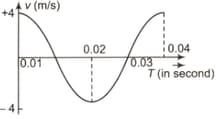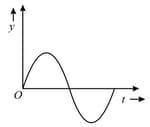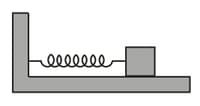Velocity and Acceleration in Simple Harmonic Motion
Velocity and Acceleration in Simple Harmonic Motion: Overview
This topic covers concepts, such as, Equation of Velocity in Terms of Displacement, Equation of Velocity in Terms of Time, Acceleration-Displacement Graph in SHM & Acceleration-Time Graph in SHM etc.
Important Questions on Velocity and Acceleration in Simple Harmonic Motion
A particle executes S.H.M with amplitudeand time period The displacement of the particle when its speed is half of maximum speed is The value of is ____________ .
A particle performs simple harmonic motion with amplitude Its speed is tripled at the instant that it is at a distance from equilibrium position. The new amplitude of the motion is
If the displacement and velocity of a particle executing SHM are related through the expression If the time period of the particle is , then what is the value of
If a simple pendulum oscillates with an amplitude of and time period of , then its maximum velocity is
The velocity-time diagram of a harmonic oscillator is shown in the below figure. The frequency of oscillation is

The displacement-time graph of a particle executing SHM is as shown in the figure.

The corresponding force-time graph of the particle is
The acceleration of a particle varies with displacement as . At and , particle is at rest. Select the correct alternative.
The vertical motion of a huge piston in a machine is approximately simple harmonic with a frequency of . A block of is placed on the piston. The maximum amplitude of the piston's simple harmonic motion, for the block and the piston to remain together is
If the maximum velocity and acceleration of a particle executing SHM are equal in magnitude, the time period will be
Particle performing starts from extreme position. Plot a graph of displacement, velocity and acceleration against time.
Particle performing starts from mean position. Plot a graph of displacement, velocity and acceleration against time.
A body describes in a path long. Its velocity at the centre of the line is Find the period, and magnitude of velocity at a distance from the central position.
A particle executes with amplitude of and period of Find the velocity, acceleration of the particle at a distance from the equilibrium position.
A particle is executing of amplitude and period of Find the speed of the particle at a point where its acceleration is half of its maximum value.
The acceleration, '' of a particle moving in a straight line varies with displacement, according to relation then velocity of the particle vary with displacement as (given that velocity is zero at zero displacement):
A highly rigid cubical block of small mass and side is fixed rigidly on to another cubical block of the same dimensions and of low modulus of rigidity such that the lower face of block completely covers the upper face of block . The lower face of block is rigidly held on a horizontal surface. A small force is applied perpendicular to one of the side faces of block . When the force is withdrawn, block executes small oscillations, the time period is given by
A particle executing S.H.M. has amplitude and frequency . The maximum acceleration of the particle is
A spring having with a spring constant is mounted on a horizontal table as shown. . A mass of is attached to the free and of the spring. Then the mass is pulled sideways to a distance of and released. Determine (i) maximum acceleration of the mass, and (ii) the maximum speed of the mass
. A mass of is attached to the free and of the spring. Then the mass is pulled sideways to a distance of and released. Determine (i) maximum acceleration of the mass, and (ii) the maximum speed of the mass
A body describes simple harmonic motion with an amplitude of and a period of . The velocity of the body when the displacement is is . Find .
A body describes simple harmonic motion with an amplitude of and a period of . Find the acceleration and velocity of the body when the displacement is .
